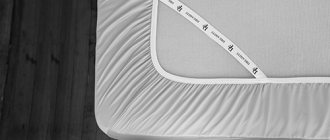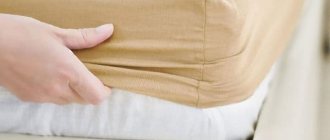Why you need to change your bed linen regularly
Every able-bodied person spends 6 to 9 hours sleeping daily; in children, depending on their age, this figure can be 10-12 hours. Every minute, dead cells peel off from human skin, and in one night several tens of millions of epidermal particles can remain on the bed. In addition, fat and sweat, which are produced by the sebaceous and sweat glands, are absorbed into the bed. Together with exfoliated skin particles, these secretions become a favorable environment for:
- dust mites;
- viruses;
- pathogenic bacteria;
- mold and fungal spores.
The rate of reproduction of harmful insects and pathogens increases if food crumbs, pollen from indoor plants, hair and dander from cats and dogs, indoor dust, and cosmetic products for hair, face and body care get on the bed.
People who neglect hygiene rules and do not adhere to the recommended frequency of changing bedding may develop:
- weakened immunity;
- tendency to fungal, viral and bacterial infections;
- allergies to house dust and other irritants;
- dermatitis;
- frequent bronchitis;
- bronchial asthma.
To avoid adverse consequences, it is necessary to change bedding sets regularly.
How often should bed linen be changed?
Sanitary standards require that fresh bedding be placed on the bed at home at least 2 times a month. Traditionally, a bedding set consists of a duvet cover, sheets and 2 pillowcases. This configuration is not accidental: the skin of a person’s face and head, compared to the body, becomes oily faster, so it is recommended to replace pillowcases more often.
Several factors influence the frequency of re-making the bed. The contamination of bedding is accelerated by:
- warm season;
- increased air temperature in the apartment;
- increased sweating due to heat, hormonal changes, fever;
- failure to comply with personal hygiene rules;
- sleeping without a nightgown or pajamas.
Regardless of a person’s age and gender, experts advise putting out fresh linen on Sunday so that the new week begins with pleasant sensations and a good, full night’s rest. Before making the bed, it is recommended to iron the sheets, duvet covers and pillowcases with a hot iron.
How often should adults change bedding?
In the cold season, when people sweat less and less dust gets into the house from the street, adults are allowed to change their bedding 2 times a month, i.e. every 2 weeks. The same frequency can be followed by those who take a shower or bath every evening and like to sleep in long nightgowns or pajamas.
In the summer, when people's sweat and sebaceous glands are actively working, and street dust, industrial gases and car exhausts enter the room through open windows and balconies, it is recommended to change underwear more often - once every 7-10 days. For those who suffer from hyperhidrosis (excessive sweating), a fresh set of bed linen should be laid every 5-7 days.
Newborn children
How often to change bedding for newborns and children under 2 years of age depends on the personal preferences of the parents and the characteristics of the organization of children's holidays. Pediatricians advise re-making cribs for infants every 3-4 days. This period may increase if the child sleeps in diapers and his urine and feces do not come into contact with the bed.
Even if there are no visible stains on the sheets and duvet covers and they look clean, the bed should be changed at least once a week. This frequency will help to avoid the child from developing allergic reactions from the organs of vision, breathing and skin.
If any stains appear on the surface of the material (traces of regurgitation and other waste products), the linen should be immediately removed and washed. Any organic matter is a breeding ground for pathogenic microbes, fungi and viruses that can undermine the infant’s still immature immune system.
Children from 2 years old
The frequency of changing bedding for children over 2 years of age depends on their activity and health. If a child likes to play on the bed, sleep with toys or a pet, a fresh bed should be made every 4-7 days. Children’s bedding should be changed with the same frequency during illness, and it is advisable to wash the pillowcase daily or every other day. A preschooler or elementary school student can change their bed linen once every 10-14 days. But provided that he takes a bath every evening and puts on pajamas or a nightgown before going to bed.
For teenagers
The onset of puberty is accompanied by hormonal changes, activation of the sebaceous and sweat glands, and changes in the chemical composition of the secretions secreted by the glands. Teenagers often suffer from excessive sweating and oily facial skin and hair. If you do not change your bedding set in a timely manner, harmful substances and pathogens will collect on the greasy fabric, which can cause the appearance or worsening of acne on the face and body.
To avoid infection of skin pores, adolescents need to change their bed at least once every 7-10 days. If the fabric quickly becomes dirty from sweat and sebum, the sheet can be changed 2 times a week, and the pillowcase - as needed.
For children suffering from severe acne, a calico or satin pillow cover should be changed every day, after ironing it with a well-heated iron. The same recommendation applies to bath accessories: a teenager should take a clean face towel every morning, or better yet, use disposable paper napkins.
For allergy sufferers and sick people
The frequency of allergic reactions or attacks of bronchial asthma can be increased by bacteria and mold spores, dust mites, and house dust falling on the surface of bedding. To reduce the risk of unwanted symptoms, a person suffering from allergies or asthma should use fresh sheets and duvet covers every 3-4 days and change their pillowcases daily. In case of infectious diseases, such as influenza or chickenpox, the bedding set must be changed every evening until the patient has completely recovered.
How often should you change sheets, pillowcases and duvet covers?
General spring cleaning after winter happens only once a year. At this time, you switch from winter bedding to summer bedding. How often should bed linen be changed?
The beginning of spring is the perfect time to get your bedroom in order. But is one big cleaning per season enough to live clean, without dust and unpleasant odors?
Most people would not like to think that they are surrounded by dirt. However, official research suggests that the bedroom may be dirtier than it seems. So how often should you change your sheets, pillows and blankets to keep your home clean?
Everything that is used during sleep requires timely care:
- sheets;
- pillowcases;
- duvet covers;
- pillows;
- blankets;
- mattresses.
Even if there are no visible stains on the bedding, the sheets and duvet covers can be quite dirty. A large study was carried out in the UK. And it turns out only a third of Brits wash their sheets weekly. And one in ten people change their sheets only once a month!
Clean bedding will lead to a better night's sleep as well as better hygiene. If you rarely change your bedding, it can easily lead to skin and eye irritations.
That's why our laundry experts recommend washing your bedding once a week. This will improve your sleep and health.
For environmentally friendly washing of bed linen, we recommend natural phosphate-free washing powders:
- Cleantown for white;
- Chistown Professional;
- Chistown Children's;
- BELIVE BABY;
- BELIVE ECO.
How often to wash
Cleaning bedding includes washing at temperatures ranging from +30...+95°C, drying and ironing. Depending on the structure and composition of the fabric, a bedding set can withstand many washes without losing its integrity, functionality and decorativeness. For example, calico can withstand more than 100 cleaning cycles, satin - more than 200, satin - about 300.
If you have to change your underwear more often than 3-4 times a month, you should purchase sets made from durable natural fabrics. Adults who care about their own hygiene and do not suffer from allergies or hyperhidrosis can buy sets made of silk or poplin - less wear-resistant fabrics.
Survey results
Rambler recently surveyed Russians about the frequency of changing and washing bed linen. This statistical study showed that many people underestimate the importance of maintaining hygiene.
A significant portion of survey participants change their bed linen only once a month. Among them were 19% women and almost 30% men.
The survey showed that there are also people who wash their bed linen only once a year. Among them there were 3% women and not a single man. From a medical point of view, such neglect of hygiene cannot but affect health.
However, most Russians wash and replace bed linen once every 2 weeks. This answer was given by 75% of women and 60% of men. But is this enough to maintain hygiene? Below we present the opinion of a specialist.
More than 790 thousand schoolchildren registered for the Unified State Exam and final exams
Rhinestones, lace, train: Elena Vorobey is getting married in an expensive dress
You won't find anything like this in a store: a man turned a fire hydrant into a coffee table
Washing rules and disinfection procedures
Sets made of calico, satin and other types of textiles will last for several years, will not shrink, will not come apart at the seams and will not fade if you follow simple care rules:
- Wash bedding separately from other items.
- Colored sets should be washed separately from plain ones. Do not mix products from several sets with different colors.
- Use the washing mode recommended by the manufacturer and indicated on the packaging or label.
- For everyday washing of lightly soiled laundry, use a temperature range of +40...+60°C. For delicate fabrics, set the water heating to +30...+40°C.
- Before washing, turn the garment inside out and remove any accumulated dust and threads from the corners.
- To disinfect linen and cotton fabrics, use the “boiling” mode.
- Remove stubborn stains with bleaches suitable for this type of textile. For undyed fabrics, use chlorine-containing preparations such as “Whiteness”; for fabrics with a printed pattern, use oxygen bleaches in the form of powder or liquid.
- Dry naturally at room temperature or in the fresh air.
- Be sure to iron. Use the mode appropriate for the type of fabric. For better smoothing and complete destruction of harmful microorganisms, use the steam function.
New bedding should be washed and ironed before first use. Treatment with water, detergents and high temperature will help clean the fabric from factory dust that has become embedded in the structure of the fibers during cutting, sewing and packaging. The first wash will rid the textile of paint particles and special preparations that are used by manufacturers to give the products a more attractive appearance.











